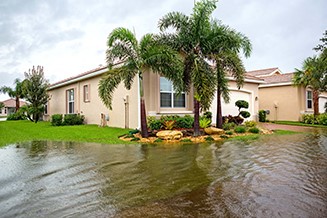Almost one-quarter of flood insurance claims are filed by people living in areas with minimal flood risk, according to the Federal Emergency Management Agency (FEMA).
The idea that you need to be close to water in order to experience flooding is a major misconception. Floods can be caused by a wide variety of factors, including storms and melting snow. Since almost any building in the country could be damaged in a flood, FEMA recommends that all renters, condominium owners, and homeowners prepare in advance for the possibility that flooding could hit their communities.
Flooding is not covered under homeowners insurance, but special flood insurance policies backed by the federal government can be purchased. Homeowners living in one of nearly 20,000 communities across the country that participate in the National Flood Insurance Program (NFIP) are eligible to purchase insurance. These communities agree to enforce flood prevention measures, such as zoning restrictions and rules for building in floodplains. In exchange, residents and businesses may purchase flood insurance through the NFIP.
Premiums vary according to risk and coverage levels, but are generally very affordable, especially for homeowners in low-moderate risk areas. It's important to know that the cost of flood insurance is highly regulated, and because of this, you won't need to shop around to find a competitive price. For more information, visit the NFIP website at www.floodsmart.gov.
Coverage Options
Flood insurance coverage is available separately for the structure of your home and your belongings. You can buy up to $250,000 in protection for the structure and up to $100,000 for the contents. Commercial structures and contents can be insured for up to $500,000 each. Be sure to ask about contents coverage, as it is not typically included with building coverage. Condo owners should check with their association to see if the master policy has flood insurance. If it doesn't, owners may want to consider buying flood coverage on their own.
It is essential to secure insurance coverage, and enough of it, before disaster strikes. Because the insurance generally does not take effect until 30 days after a policy is purchased, you cannot afford to wait until water is lapping at your door. It's also wrong to assume the federal government will foot the bill for repairing your home. Federal assistance is only available if the President has formally declared a disaster, and then the assistance offered may come in the form of a loan tacked onto your existing mortgage.
One of the great benefits of flood insurance is that it will pay out even when a disaster is not declared. And, it's both easy to get and pay for. In most cases, it can be escrowed into your mortgage or paid for by credit card.
Preventing Water Damage
There are steps you can take to mitigate damage to your home if flooding occurs. Consider installing sump pumps with backup power in the basement. If possible, ensure that the electric fuse box, electric outlets, light sockets, baseboard heaters, and wiring are all located at least 12 inches above the projected flood elevation for your home. Furnaces, water heaters, and major appliances should be similarly placed.
To prevent sewage from backing up and entering your home in a flood, have a plumber install an interior or exterior back-flow valve. If the risk of your home being flooded is high, you may want to consider sealing any openings around the base of the house, installing a drainage system, constructing flood walls, or improving exterior walls. Also, move your most valuable items, especially important documents and family photographs, to the upper floors of the house.
Finally, practice a flood evacuation with your family, reminding them to stay safe by avoiding flowing water and downed power lines. Floods can be both dangerous and destructive, but even a small amount of preparation can go a long way toward protecting your family and your property.





